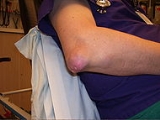
Tophus
Encyclopedia
A tophus is a deposit of monosodium urate
crystal
s in people with longstanding high levels of uric acid in the blood
. Tophi are pathognomonic for the disease gout
. Most people with tophi have had previous attacks of acute arthritis, eventually leading to the formation of tophi.
Tophi form in the joints, cartilage
, bone
s, and other places throughout the body. Sometimes, tophi break through the skin
and appear as white or yellowish-white, chalky nodules. Without treatment, tophi may develop on average about ten years after the onset of gout
, although their first appearance can range from three to forty-two years. They are more apt to appear early in the course of the disease in people who are older in age. In the elderly population, women appear to be at higher risk for tophi than men.
Although less common, tophi can also form in the kidneys and nasal cartilage.
Uric acid
Uric acid is a heterocyclic compound of carbon, nitrogen, oxygen, and hydrogen with the formula C5H4N4O3. It forms ions and salts known as urates and acid urates such as ammonium acid urate. Uric acid is created when the body breaks down purine nucleotides. High blood concentrations of uric acid...
crystal
Crystal
A crystal or crystalline solid is a solid material whose constituent atoms, molecules, or ions are arranged in an orderly repeating pattern extending in all three spatial dimensions. The scientific study of crystals and crystal formation is known as crystallography...
s in people with longstanding high levels of uric acid in the blood
Hyperuricemia
Hyperuricemia is a level of uric acid in the blood that is abnormally high. In humans, the upper end of the normal range is 360 µmol/L for women and 400 µmol/L for men.-Causes:...
. Tophi are pathognomonic for the disease gout
Gout
Gout is a medical condition usually characterized by recurrent attacks of acute inflammatory arthritis—a red, tender, hot, swollen joint. The metatarsal-phalangeal joint at the base of the big toe is the most commonly affected . However, it may also present as tophi, kidney stones, or urate...
. Most people with tophi have had previous attacks of acute arthritis, eventually leading to the formation of tophi.
Tophi form in the joints, cartilage
Cartilage
Cartilage is a flexible connective tissue found in many areas in the bodies of humans and other animals, including the joints between bones, the rib cage, the ear, the nose, the elbow, the knee, the ankle, the bronchial tubes and the intervertebral discs...
, bone
Bone
Bones are rigid organs that constitute part of the endoskeleton of vertebrates. They support, and protect the various organs of the body, produce red and white blood cells and store minerals. Bone tissue is a type of dense connective tissue...
s, and other places throughout the body. Sometimes, tophi break through the skin
Skin
-Dermis:The dermis is the layer of skin beneath the epidermis that consists of connective tissue and cushions the body from stress and strain. The dermis is tightly connected to the epidermis by a basement membrane. It also harbors many Mechanoreceptors that provide the sense of touch and heat...
and appear as white or yellowish-white, chalky nodules. Without treatment, tophi may develop on average about ten years after the onset of gout
Gout
Gout is a medical condition usually characterized by recurrent attacks of acute inflammatory arthritis—a red, tender, hot, swollen joint. The metatarsal-phalangeal joint at the base of the big toe is the most commonly affected . However, it may also present as tophi, kidney stones, or urate...
, although their first appearance can range from three to forty-two years. They are more apt to appear early in the course of the disease in people who are older in age. In the elderly population, women appear to be at higher risk for tophi than men.
Although less common, tophi can also form in the kidneys and nasal cartilage.

